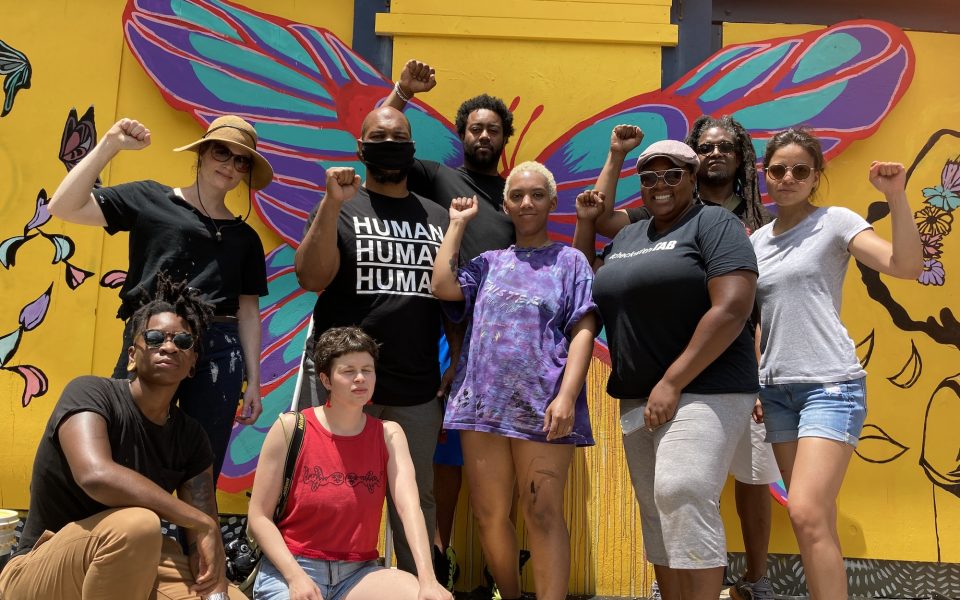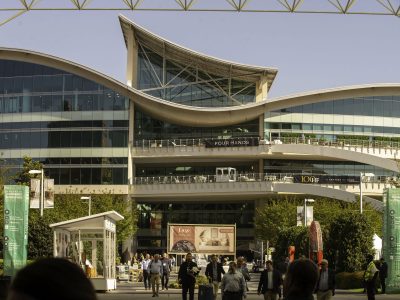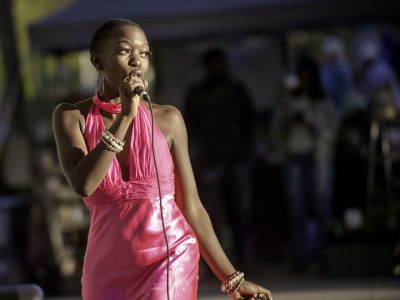Darlene McClinton gingerly paints the young girl’s afro with black paint, carefully filling in the cloudlike shape of her hair to create soft texture and volume. The artist’s eyes are obscured by the reflective sunglasses she wears, but her vision has always been clear.
“Art is a visual language,” McClinton says. “All of us right here, we all communicate visually. One of the things I love about public art is that it’s a stage. Public art is a platform. It is our responsibility as artists to abuse the ears of the people that’s visually listening to the work of art.”
McClinton, the co-founder of the Artist Bloc and a professor at NC A&T University, has been creating art and mobilizing artists for years. A painter by trade, she grew up in Greensboro and has been working in the city for the past decade to help foster relationships between the community and the arts.

On Thursday, McClinton works with a group of artists in front of Elsewhere in Greensboro painting a vast, bright golden mural — one of the newest to pop up downtown after businesses began boarding up their windows in the wake of protests for black lives.
“It started from the protesting and the looting and a bunch of artists at one time were seeing all of the wood panels being placed up in front of the storefronts to protect their property,” McClinton says. “And as an artist, when we see wood panels, we see blank walls, we see blank canvases. We thought it was a great time to express ourselves.”
McClinton says she and Phillip Marsh, another community artist, noticed that many of the prominent murals being created were by white artists. Examples include pieces like the portrait of George Floyd outside of Crafted: Art of the Street Taco painted by artist Jenna Rice. Artist Gina Franco worked with Vintage to Vogue’s owner Jennifer Graf to coordinate artists, including many black artists, to create several pieces downtown.
“We noticed that it was a lot of white artists painting our stories,” McClinton says. “We needed to come out here and get black artists to paint because we are living through this moment, we’re living through this time and we are experiencing this.”
Marsh, who owns Rockers Print Shop, a graphic and fine-art firm, has also been working with the city for years to create public art. He says that the influx of murals in the wake of the protests is exciting but that black artists shouldn’t be relegated to the sidelines.

“In the beginning everyone saw this opportunity to get art up in a place that it never has before and probably will never be again, which is on storefronts on main street,” Marsh says. “We’re in a very necessary moment. We’re doing intentional black art which is political in and of itself because usually we are the token on projects, and in this situation, it’s being led by black artists.”
The mural at Elsewhere — which was collaboratively designed and created by McClinton and Marsh, along with artists Jamin Guinyard, Neidy Perdomo, Kidd Graves, Tambra Parsons, Xavier Carrington and Quadasia Prescod — depicts the transformation and growth of a young black girl from childhood into adulthood.
The idea, McClinton says, was to show how racism can affect a black individual throughout their life. The young girl that McClinton is painting holds a small flower with her outstretched hand. McClinton explains how she’s innocent and has no idea the kind of hate that can exist in the world. In the next panel, she’s older, in middle school and is starting to reflect on her experiences. She smells a larger flower that she holds to her face. Further down the line, the girl is a teenager and wears flowers in her hair and has her fist raised in the air. And finally, at the end of the mural, the girl has transformed into a woman whose peaceful face is angled back towards her past selves. She lets the flora around her flourish.
“We decided to use a black woman because there’s going to come a time soon when black women will rise to become leaders,” McClinton explains. “I mean, we’re already leaders but we’ll start to be acknowledged as leaders…. Having a black woman was intentional.”
Guinyard finished their own mural last week on a wall at the corner of South Elm and Lewis streets. Guinyard, who is one of McClinton’s students, says they got started creating art digitally but soon moved into working with their hands. Their mural depicts an androgynous black figure, painted in shades of gray and black, their face covered by a large red target. Next to the image in large font, Guinyard writes, “In America, it is TRADITIONAL to destroy the black body!!”

“I felt like I had a duty to be out here as a black woman to let my voice be heard especially right now during everything that’s going on,” Guinyard says. “I think it’s very important for people to actually take a step back and listen to black people and listen to what they have to say.”
Even though Guinyard has been creating art for years, they said they didn’t know about the opportunity to create art downtown until Marsh reached out to them. And that’s a problem, they say.
“I think that just goes to show that what we’re fighting for needs to be fought for,” they said. “At the end of the day, I know there were a lot of white people and I know they did have good intentions, but at the same time they did silence a lot of black voices and that is a theme…. It just goes to show that we have a long way to go.”
Marsh, who created several other murals downtown recently, says he wants to make sure black artists are represented in this moment and in the future.
When Jenna Rice’s mural of George Floyd was vandalized a few weeks ago, Marsh says Mayor Nancy Vaughan released a statement condemning the act but failed to include the fact that other works of art by black artists, including ones at a black barber shop, were also vandalized with white supremacist phrases.
“If you have artists out here that aren’t from the community that’s affected it would be less of an opportunity to get real art up, political art up,” Marsh says. “This is a state of emergency. When I saw what was going on, I thought that it was intentional and it’s actually almost violent…. It’s also an indictment on the elite in this city that you don’t have working relationships with these black artists in the first place.”

McClinton says she hopes the mural at Elsewhere as well as others created by black artists in downtown send a message of change.
“I’m educating people through my work,” McClinton says. “I believe that public art is an educational tool that educates the community. It’s a healing power. It’s a voice. The power of art can change lives…. The power of art can influence people to do the right thing.”
Here are some other murals and works created by black artists that are downtown. Click the picture to enlarge. See your piece? Reach out to [email protected] to update the caption!
-

Mural at Fat Tuesdays by Imani Lane -

Mural at Fat Tuesdays by Imani Lane -

Left by Jasmine Franco @jasminefrancosart -

-

Mural by Ashley Griffin -

Mural by Ahmad -

Community mural at Vivid Interiors -

Community mural at Vivid Interiors -

Community mural at Vivid Interiors -

Community mural at Sonders Mind and Body -

Community mural -

Unfinished mural by Grip Wayne McDuffie at Dudley Hair Salon -

Mural by Jennifer Ken @JKen_Art at Artistika -

Mural by @KreativeKayys -

Chalk mural at corner of Elm and Lewis Streets -

Mural by Carly Judd at Boxcar -

Mural by Virginia Holmes next to Cheesecakes by Alex -

Mural at Triad Stage by Darlene McClinton -

Mural outside of Jimmy Johns by @Alex_BTM -

Mural by Marquisha Richards outside of Lao -

Mural outside of Aspen Boutique by Harmony Granderson -

Mural by Katie Hutchinson at 1618 Downtown -

Mural outside of Jimmy Johns by @Alex_BTM -

Mural by Marshall on Elm St. -

-

Mural by Phillip Marsh -

Murals at Realigned -

Mural by Essence Imani Foster @visnatura_ -

Mural by @too.shi at Realigned -

Mural at Just Be by Xavier Carrington (@bigplayzay) -

-

-

Mural at Heavenly Buffaloes by Phillip Marsh -

Mural outside of Bonchon by Imani Lane @black.girl.blessed -

Mural by Chimeri Anazia at Old Photo Specialists (courtesy photo)
Join the First Amendment Society, a membership that goes directly to funding TCB‘s newsroom.
We believe that reporting can save the world.
The TCB First Amendment Society recognizes the vital role of a free, unfettered press with a bundling of local experiences designed to build community, and unique engagements with our newsroom that will help you understand, and shape, local journalism’s critical role in uplifting the people in our cities.
All revenue goes directly into the newsroom as reporters’ salaries and freelance commissions.





Leave a Reply